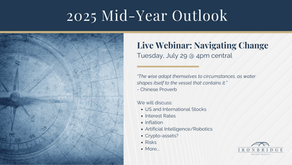
Live Your Best Life
We are fiduciaries who have your back.
Working with a wealth management team should free your time and allow you to pursue your passions. We are fiduciaries who help remove the worry from your financial life.
Check us out on social media!

What Makes us Different?
Most wealth managers invest in a static, overly-diversified portfolio, hoping everything works out okay. These strategies ignore the fact that markets work in cycles with differing investment opportunities in different stages of the cycle.
1
Forward Thinking
We combine the foundations of traditional wealth management with a forward-thinking approach to risk, return and planning.
2
Accountable
IronBridge is a 100% Fiduciary firm. As a Registered Investment Advisor, we are held to the highest standard of care, highly regulated, and committed to serving the best interest of our clients.
3
Process-Driven
We have developed and refined disciplined processes for financial planning and portfolio management, to help ensure your financial goals are met with the highest probability possible.
Don't Leave it to Chance
Our wealth management process integrates your portfolio, financial plan, real estate and business ownership in a customized strategy to help maximize your wealth.

Active Management
Hope is not an investment strategy. We have developed proprietary investment processes to help navigate market cycles.

Proactive Communication
Confidence results from knowing your plan is on track to achieve your goals.

Meaningful Advice
We learn about your unique goals and customize a plan to help you achieve those goals.

Investment Fee Options
You now have a choice on how you compensate your wealth management team.
Jim Denholm, CMT
Founder & CEO
"Our mission is to provide you with confidence in any market environment and in any phase of life, so you can live your best life possible."

Communication with You in Mind
Financial markets are some of the most complex systems in the world. To successfully navigate them, you must accept the reality of the current market conditions, not hope for something different.
Our publications are designed to keep you informed of trends that may affect your wealth.
IronBridge Insights
Our market analysis discusses the reality of the current market environment, identifies key drivers to watch, and provides a sense of how your portfolio is positioned. All while trying to avoid over-generalized investment jargon.
Strategic Wealth Blog
Our blog posts are short articles focused on ways to help grow your wealth. Topics include investment strategies, legislative updates, private investments, and financial planning considerations.
Videos & Webinars
Videos and webinars help deepen your understanding of financial markets, as well as staying up to date on market driving events.






